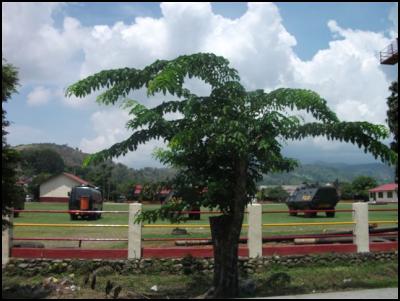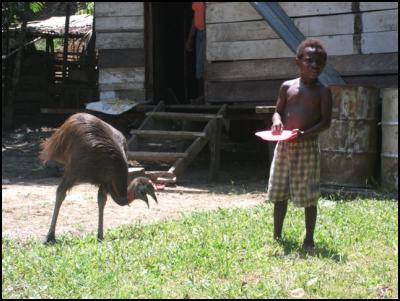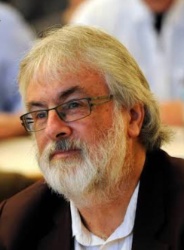West Papua, search for justice: an eyewitness perspective
West Papua and the search for justice: an eyewitness perspective
One of the great things about my November visit to West Papua was the chance to reconnect with some of the special people who have been here to New Zealand on speaking tours over the last few years.
I called on Rev Socratez Yoman, the leader of the Baptist Churches in West Papua, and one of the most outspoken advocates for peace and justice. Socratez’ name was at the head of a list of Papuan leaders targeted in a leaked Kopassus document exposed in November by US journalist Alan Nairn.
Socratez told me he was not concerned about being labelled as an ‘enemy of the state’ because his job is about protecting ‘God’s people’.
When he visited here four years ago Socratez brought power point images to illustrate the problem of unrestrained migration of people from other parts of Indonesia. The reality hit me as I moved about the capital Jayapura and later the southern city of Merauke.
Indigenous Papuans, their religious life and their cultural icons are devalued and marginalised. In the business and trading sector migrants dominate while the Papuan women sell their beautiful craft work and their fresh produce on the pavement outside the glossy western style supermarkets or at the night market which functions as a carpark during the day. At one market it was disconcerting to note that even betel nut was being sold by migrants. “Betel nut is our thing” my friends told me.
Chief Theys Eluay was a charismatic Papuan independence leader who was murdered by Kopassus forces in late 2001. His grave, close to the airport at Sentani was pointed out to me but I was warned that taking a photo would almost certainly prompt a security force response. Perhaps it was not intentional, but it seemed symbolic that I later saw that the site had been hidden behind a large banner promoting the forthcoming visit of President Susilo Bambang Yudhoyono.
Papuan society is predominantly Christian and most migrants are Muslim. The Islamic holiday of Idul Adha fell during my visit and I chanced upon an impressive convoy of vehicles proceeding to the main mosque, with loudspeakers going full tilt. There were army, police and naval vehicles in the parade helping to take the worshippers to the celebration. What happens when there is a Christian holiday I asked - well the police would be around - but only to provide 'security'.
I should also have been prepared for the dominance of the security forces in West Papua, but again the reality was something else. Policemen and soldiers seemed to be everywhere - restaurants, shops, driving or walking through the town. In the rural areas it was little different. I visited a small village of perhaps 30 or 40 houses - no electricity no phone, no running water and no transport service - but its very own TNI post keeping track of everyone's movements.

In Jayapura the immaculate Brimob base was particularly formidable - with five tank like vehicles, two armoured ‘buses’ and one shiny new anti-terror vehicle equipped with water cannon. All were lined up on the parade ground in full view of the main street. During my visit I saw the vehicles deployed -waiting in readiness in central Jayapura while a 50 or 60 strong 'reject autonomy' demonstration took place at the provincial parliament building. Fortunately, on this occasion there were no arrests, but it would be hard to overestimate the courage of those who gather knowing that their actions are always being monitored. The 'intel' will be around close by riding an ojek (motor bike taxi) or 'selling' food on a stall.
The West Papuan people are aware that the international media has recently increased its coverage of the ongoing conflict. They know of the impact of the leaked military video graphically depicting the brutal torture of two highland men. Of course they told me that this is only one example of the kind of suffering and abuse experienced by people in the remote Puncak Jaya area where the military have been conducting ‘sweeping operations’ for the last seven years.
It is understandable that Papuans seize on any international political initiatives which address their grievances. In September a US Congressional Hearing, an initiative of American Samoan Congressman Eni Faleomaevaga, looked into crimes against humanity in West Papua and heard testimony from Papuan leaders and academics. Although it was a historic event, Papuan expectations of a major change in US foreign policy were doomed to disappointment.
Since Indonesia took control of the territory over forty years ago most Papuans have had little opportunity to interact with the outside world, or to understand the realities of geopolitical power plays. I did not relish trying to explain how it is that my Government does not do more to support Papuan rights.
New Zealand’s programme for training West Papuan police in community policing came up for discussion and the responses were revealing. One suggested that we should instead train the unofficial ‘Papua Satgas’, the unarmed task force that stands guard at Papuan events and demonstrations. Others were sceptical if not hostile towards a training programme which supports the coercive power of the Indonesian authorities. One student summed it up his anger at a meeting of younger activists “New Zealand go to hell!”
On the other hand, people were delighted to learn about the campaigns in solidarity with West Papua, and very happy to hear that we raise the Morning Star flag each December 1. I discussed our opposition to the NZ Super Fund investment in the Freeport McMoran mine and our opposition to the import into New Zealand of kwila (known in Papua as merbau).
I visited an area where a well-established palm oil plantation has taken over ancestral land. Tribal leaders told me that they were still struggling to protect remaining land and were pleased that a representative had been able to join an NGO lobby in Jakarta. The local people have had little choice but to work for the company.
I told them of our ‘don’t buy kwila’ and anti-palm oil actions. I started to explain our demonstration ‘props’ and our cassowary costume when one of the men said ‘There’s a cassowary - just over there in the neighbour’s garden.” Actually, this particular cassowary had been reared as a family pet – but for me the moment was no less precious!

Disturbingly, I also learnt about the latest resource exploitation issue confronting the indigenous people in West Papua: the Merauke Integrated Food and Energy project, MIFEE. This is a plan to cover as much as 1.6 million hectares with commercial plantations of crops such as rice, corn, sugar cane, palm oil, and the government is encouraging foreign investment and considering making the area a special economic zone.
The Government ‘s vision for Mifee is that it will become the bread basket for the nation’s burgeoning population and even boost Indonesia’s exports. The Mifee project was established by Presidential decree but no-one asked the owners of the land – the people of the Malind tribe.
Merauke was a
favoured area at the height of the transmigration era, but
now there will be a potential influx of unbelievable
numbers. The current population stands at around 300,000
but it has been suggested that hundreds of thousands (if not
millions) will be needed for the labour intensive new
plantations. Of 20 districts in the regency only 6 are not
slated to have MIFEE food or energy projects. For energy
read palm oil plantations.
WWF has mapped the area and documented the Papuan sacred sites, the paths for migratory birds, the water catchments, the fragile savannah areas, the virgin forests and the mangroves. WWF’s work crosses the border into Papua New Guinea as ecology does not respect political boundaries. But will the authorities respect this and other environmental impact assessments?
Pilot projects are already under way and over 30 major Indonesian and international conglomerates, such as Wilmar, Sinarmas and Medco have already signed on the project.
A new coalition has formed to oppose MIFEE: SORPATOM “Papua People’s Solidarity to reject MIFEE” and it brings together tribal leaders, Church leaders, and younger activists. They are making much of the new International Declaration on the Rights of Indigenous People and I was pleased to hear from international delegates to a recent Auckland conference about the declaration that they are well aware of the MIFEE project and its implications for ancestral land rights. But there needs to be a much stronger international lobby to save this beautiful area and its people from destruction.
In August, journalist Ardiansyah Matrais, who was writing about MIFEE was found drowned in a Merauke river, and police declined to investigate his death. Opponents of the MIFEE project fear that they are being targeted by the military intelligence, and one leader who wanted to talk to me sought out a dimly lit venue where a noisy air-conditioner provided extra privacy.
I think for some the idea of sitting down to dialogue with Indonesia after decades of killings and conflict is anathema. But the call for peaceful dialogue with Indonesia is gaining wide support. Academic Fr NelesTebay is a key architect of the work to persuade Indonesia to talk to accredited representatives of the Papuan movement and he remains optimistic. He notes that, while Indonesia still equates the call for dialogue with dangerous ‘separatism’ the Indonesian President has suggested 'constructive communication' could be considered.
Meanwhile the Papuan peacemakers and the Papuan Customary Council will go on with the process of community consultations, so that Papuans are ready and have chosen their representatives when the time comes.
It has never been easy for the Papuan resistance to achieve a common strategy – a major reason is the territory’s rugged geography and its poor transport and communication networks. However, over the last few years the Papuan leadership has worked hard to unite the different forces, including the OPM or Free Papua Movement. The two major activist coalitions have recently reached an agreement to work together.
A highlight of my visit was my meeting with former political prisoner Yusak Pakage. He believes that his release last July after serving only half of his ten year sentence is due to to international support. Yusak managed to teach himself English in detention and asked me to pass on his heartfelt thanks to Amnesty International and all those in New Zealand who had supported the campaign for his release. Yusak was badly beaten in prison when he tried to protest about the maltreatment of other activists, and he says he continues to be subject to military intimidation.
Yusak’s ‘crime’? He and Filep Karma raised the banned West Papua Morning Star flag during a peaceful demonstration in late 2004. Filep and many others remain in jail for daring to express their political aspirations.
New Zealand could do so much more - our role in mediating an end to the conflict in Bougainville is widely known and many hope that we could fill the same role for West Papua. The “hidden” conflict in West Papua is not quite so hidden now. But it will be important to keep up the momentum of solidarity work to ensure that the issues become better known and our Government comes under strong pressure to support peace and justice.
Maire
Leadbeater is a spokesperson for the Indonesia Human Rights
Committee, Auckland.
December 6,
2010


 Binoy Kampmark: Secrecy And Virtue Signalling - Another View Of Signalgate
Binoy Kampmark: Secrecy And Virtue Signalling - Another View Of Signalgate Gordon Campbell: On The Americanising Of NZ’s Public Health System
Gordon Campbell: On The Americanising Of NZ’s Public Health System Ian Powell: Trumpian Health Leadership
Ian Powell: Trumpian Health Leadership Eugene Doyle: Disruption - Historians Challenge Russophobic Propaganda
Eugene Doyle: Disruption - Historians Challenge Russophobic Propaganda Ramzy Baroud: War, Doublethink, And The Struggle For Survival - Geopolitics Of The Gaza Genocide
Ramzy Baroud: War, Doublethink, And The Struggle For Survival - Geopolitics Of The Gaza Genocide Binoy Kampmark: Authoritarian Politics - Netanyahu’s War On Israeli Institutions
Binoy Kampmark: Authoritarian Politics - Netanyahu’s War On Israeli Institutions